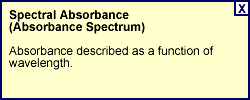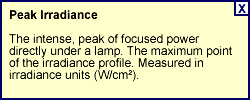Guide to UV Measurement
Process Design vs Process Control
Process design is the optimization of the UV exposure conditions based on the requirements of a paint, ink, coating, or adhesive. A typical laboratory method is to vary formulation ingredients and/or UV exposure, and evaluate the resulting cured material. Generally, the material's spectral absorbance, optical thickness, and photoinitiator types and concentration determine what exposure is most effective. Attaining a specific set of physical properties in the cured film on an end-product is ultimately what is important, and design information is critical to achieving an efficient process with an adequate operating range, or “window.”
PROCESS DESIGN
|
The process design phase determines exposure requirements such as peak irradiance and focus, irradiance profile, spectral distribution , power level, peak-to-energy ratio, temperature, and time. Radiometric measurements are useful in quantifying the successful exposure parameters, so the process can be reliably duplicated. The function of radiometry is to provide quantitative information about the critical requirements of the process and to establish the limits within which the process is successful.
PROCESS MONITORING |
Process control maintains the process within the “window” of operating limits. The primary purpose is to know when something has changed before it threatens the process. If the radiometric data collected doesn’t relate to the process “window,” it doesn’t mean much. For example, if the chemistry requires UV wavelengths in the 250 nm region, measurement in the 365 nm region would not be relevant. Also, if lamp design characteristics such as irradiance profile or spectral radiance have been determined in the design of the system, it is not necessary to repeatedly measure these for process control -- unless they are expected to change. Proper measurements can be valuable to determine when replacement or maintenance is required as lamps age or become dirty. For more on setting process exposure limits, see “ The Thin Red Line” in the Resources section.

